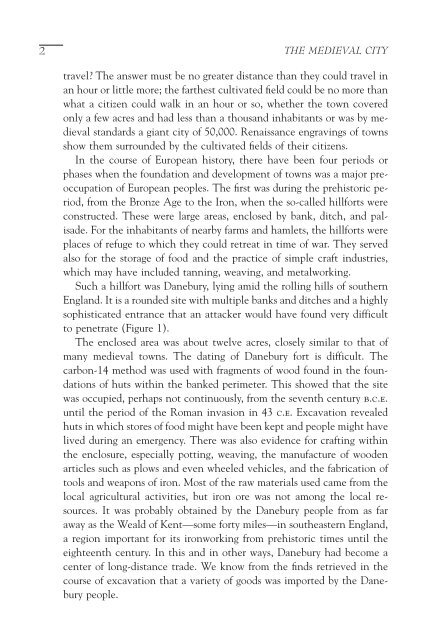CITIES AND TOWN The medieval city.pdf
CITIES AND TOWN The medieval city.pdf
CITIES AND TOWN The medieval city.pdf
Create successful ePaper yourself
Turn your PDF publications into a flip-book with our unique Google optimized e-Paper software.
2<br />
THE MEDIEVAL CITY<br />
travel? <strong>The</strong> answer must be no greater distance than they could travel in<br />
an hour or little more; the farthest cultivated field could be no more than<br />
what a citizen could walk in an hour or so, whether the town covered<br />
only a few acres and had less than a thousand inhabitants or was by <strong>medieval</strong><br />
standards a giant <strong>city</strong> of 50,000. Renaissance engravings of towns<br />
show them surrounded by the cultivated fields of their citizens.<br />
In the course of European history, there have been four periods or<br />
phases when the foundation and development of towns was a major preoccupation<br />
of European peoples. <strong>The</strong> first was during the prehistoric period,<br />
from the Bronze Age to the Iron, when the so-called hillforts were<br />
constructed. <strong>The</strong>se were large areas, enclosed by bank, ditch, and palisade.<br />
For the inhabitants of nearby farms and hamlets, the hillforts were<br />
places of refuge to which they could retreat in time of war. <strong>The</strong>y served<br />
also for the storage of food and the practice of simple craft industries,<br />
which may have included tanning, weaving, and metalworking.<br />
Such a hillfort was Danebury, lying amid the rolling hills of southern<br />
England. It is a rounded site with multiple banks and ditches and a highly<br />
sophisticated entrance that an attacker would have found very difficult<br />
to penetrate (Figure 1).<br />
<strong>The</strong> enclosed area was about twelve acres, closely similar to that of<br />
many <strong>medieval</strong> towns. <strong>The</strong> dating of Danebury fort is difficult. <strong>The</strong><br />
carbon-14 method was used with fragments of wood found in the foundations<br />
of huts within the banked perimeter. This showed that the site<br />
was occupied, perhaps not continuously, from the seventh century b.c.e.<br />
until the period of the Roman invasion in 43 c.e. Excavation revealed<br />
huts in which stores of food might have been kept and people might have<br />
lived during an emergency. <strong>The</strong>re was also evidence for crafting within<br />
the enclosure, especially potting, weaving, the manufacture of wooden<br />
articles such as plows and even wheeled vehicles, and the fabrication of<br />
tools and weapons of iron. Most of the raw materials used came from the<br />
local agricultural activities, but iron ore was not among the local resources.<br />
It was probably obtained by the Danebury people from as far<br />
away as the Weald of Kent—some forty miles—in southeastern England,<br />
a region important for its ironworking from prehistoric times until the<br />
eighteenth century. In this and in other ways, Danebury had become a<br />
center of long-distance trade. We know from the finds retrieved in the<br />
course of excavation that a variety of goods was imported by the Danebury<br />
people.
















